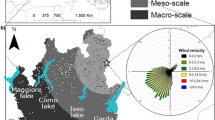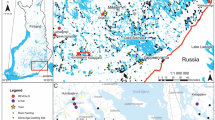Abstract
The focus of palaeoenvironmental sciences on past human activities and their impact on the environment necessitates a precise understanding of the history and functioning of past and present anthropogenic ecosystems. A process is outlined which uses palaeoenvironmental and historical documentation as well as present-day observations of vegetational changes from two different plant communities, which are characterised by a very specific anthropogenic flora: arable weeds and ruderals. This study is coupled with modern pollen deposition data to deduce a set of pollen types characteristic of the range of human activities practised in eastern France, a region rich in pollen data. First, phytogeographical analysis of the evolution of these plant communities since the Neolithic enables the comparison to be validated. By distinguishing between native plants and aliens introduced long ago (archaeophytes), or more recently (neophytes), and by refining their ecological characteristics, the method also enables identification of species that are strong indicators of human activities. Next, local pollen deposition in these vegetation types is examined with a number of statistical analyses (PCIA, Davis indices), confirming the relationships between a given vegetation community, its theoretical pollen rain and its actual pollen rain, thus distinguishing local and regional pollen indicators. Lastly, comparison of the results obtained by these two approaches leads to a critical synthesis of the traditional anthropogenic pollen indicators (Behre’s “indicator species”) in the study area and to the establishment of more specific local pollen indicators.
Similar content being viewed by others
References
Behre K-E (1981) The interpretation of anthropogenic indicators in pollen diagrams. Pollen Spores 23:225–245
Behre K-E (1988) The role of man in European vegetation history. In: Huntley BW, Webb T III (eds) Vegetation history. Kluwer, Dordrecht, pp 633–672
Behre K-E (2007) Evidence for Mesolithic agriculture in and around Central Europe? Veget Hist Archaeobot 16:203–219
Behre K-E (2008) Comment on: “Mesolithic agriculture in Switzerland? A critical review of the evidence” by W. Tinner, E.H. Nielsen and A.F. Lotter. Quat Sci Rev 27:1,467–1,468
Berglund BE, Ralska-Jasiewiczowa M (1986) Pollen analysis and pollen diagrams. In: Berglund BE (ed) Handbook of Holocene palaeoecology and palaeohydrology. Wiley, Chichester, pp 155–484
Beug H-J (2004) Leitfaden der Pollenbestimmung für Mitteleuropa und angrenzende Gebiete. Pfeil, Munich
Bock B (2005) Base de données Nomenclaturales de la Flore de France—BdNFF version 4.02—mars 2005. Tela Botanica. http://www.tela-botanica.org/eflore (From Kerguélen, M. 1999: Index Synonymique de la Flore de France. Version 1999)
Broström A, Gaillard M-J, Ihse M, Odgaard B (1998) Pollen-landscape relationships in modern analogues of ancient cultural landscapes in southern Sweden—a first step towards quantification of vegetation openness in the past. Veget Hist Archaeobot 7:189–201
Broström A, Nielsen AB, Gaillard M-J, Hjelle K, Mazier F, Binney H, Bunting J, Fyfe R, Meltsov V, Poska A, Räsänen S, Soepboer W, von Stedingk H, Suutari H, Sugita S (2008) Pollen productivity estimates of key European plant taxa for quantitative reconstruction of past vegetation: a review. Veget Hist Archaeobot 17:461–478
Brun C (2009) Biodiversity changes in highly anthropogenic environments (cultivated and ruderal) from the Neolithic to present day in the eastern part of France. Holocene 19:861–871
Brun C, Dessaint F, Richard H, Bretagnolle F (2007) Arable-weed flora and its pollen representation: a case study from the eastern part of France. Rev Palaeobot Palynol 146:29–50
Brun C, Dessaint F, Richard H, Bretagnolle F (2008) La flore des milieux rudéraux et sa représentation pollinique: une nouvelle approche pour la reconstruction des paléoenvironnements humains. In: Galop D (ed) Paysages et environnement. De la reconstitution du passé aux modèles prospectifs. Presses universitaires de Franche-Comté, Besançon (Annales littéraires. Série Environnement, sociétés et archéologie), pp 193–204
Bunting MJ (2003) Pollen–vegetation relationships in non-arboreal moorland taxa. Rev Palaeobot Palynol 125:285–298
Court-Picon M, Buttler A, de Beaulieu J-L (2006) Modern pollen/vegetation/land-use relationships in mountain environments: an example from the Champsaur valley (French Alps). Veget Hist Archaeobot 15:151–158
Davis OK (1984) Pollen frequencies reflect vegetation patterns in a Great Basin (U.S.A.) mountain range. Rev Palaeobot Palynol 40:295–315
Dray S, Chessel D, Thioulouse J (2003) Procrustean co-inertia analysis for the linking of multivariate datasets. Écoscience 10:110–119
Ellenberg H (1979) Zeigerwerte der Gefäßpflanzen Mitteleuropas. Scripta Geobotanica 9, Göttingen
Fægri K, Iversen J (1989) Textbook of pollen analysis, 4th edn. by Fægri K, Kaland PE, Krzywinski K. Wiley, Chichester
Gaillard M-J, Birks HJB, Emanuelsson U, Berglund BE (1992) Modern pollen/landuse relationships as an aid in the reconstruction of past land-uses and cultural landscapes: an example from south Sweden. Veget Hist Archaeobot 1:3–17
Gaillard M-J, Birks HJB, Emmanuelson U, Karlson S, Lagerås P, Olausson D (1994) Application of modern pollen/land-use relationships to the interpretation of pollen diagrams—reconstructions of land-use history in south Sweden, 3000–0 BP. Rev Palaeobot Palynol 82:47–73
Galop D (1998) La forêt, l’homme et le troupeau dans les Pyrénées. 6000 ans d’histoire de l’environnement entre Garonne et Méditerranée. Contribution palynologique, Framespa, Toulouse
Galop D, Mazier F, Lopez-Saez J-A, Vannière B (2003) Palynologie et histoire des activités humaines en milieu montagnard. Bilan provisoire des recherches et nouvelles orientations méthodologiques sur le versant nord des Pyrénées. Archéologie du midi médiéval 21:159–170
Gauthier E (2004) Forêts et agriculteurs du Jura: les quatre derniers millénaires. (Annales littéraires. Série Environnement, sociétés et archéologie, 6) Presses universitaires franc-comtoises, Besançon
Hicks S (1988) The representation of different farming practices in pollen diagrams from northern Finland. In: Birks HH, Birks HJB, Kaland PE, Moe D (eds) The cultural landscape—past present and future. Cambridge University Press, Cambridge, pp 188–207
Hjelle KL (1997) Relationships between pollen and plants in human influenced vegetation types using presence–absence data in western Norway. Rev Palaeobot Palynol 99:1–16
Hjelle KL (1999) Modern pollen assemblages from mown and grazed vegetation types in western Norway. Rev Palaeobot Palynol 107:55–81
Holub J, Jirásek V (1967) Zur Vereinheitlichung der Terminologie in der Phytogeographie. Folia Geobot Phytotax 2:69–113
Jalut G (1991) Le pollen, traducteur du paysage agraire. In: Guilaine J (ed) Pour une archéologie agraire. Armand Collin, Paris, pp 345–368
Julve P (1998) Baseflor. Index botanique, écologique et chorologique de la flore de France. http://perso.wanadoo.fr/philippe.julve/catminat.htm. Accessed 9 April 2007
Marguerie D (1992) Evolution de la végétation sous l’impact anthropique en Armorique du Mésolithique au Moyen Âge: étude palynologiques et anthracologiques des sites archéologiques et des tourbières associées. Doctoral thesis, Université de Rennes, Rennes
Mazier F, Galop D, Brun C, Buttler A (2006) Modern pollen assemblages from grazed vegetation in the western Pyrenees, France: a numerical tool for more precise reconstruction of past cultural landscapes. Holocene 16:91–103
Oberdorfer E (1970) Pflanzensoziologische Exkursionsflora für Süddeutschland. Ulmer, Stuttgart
Preston CD, Pearman DA, Hall A (2004) Archaeophytes in Britain. Bot J Linn Soc 145:257–294
Proctor M, Yeo P, Lack A (1996) The natural history of pollination. Harper Collins, London
Pyšek P, Sádlo J, Mandák B (2002) Catalogue of alien plants of the Czech Republic. Preslia 74:97–186
Pyšek P, Richardson DM, Rejmánek M, Webster GL, Williamson M, Kirschner J (2004) Alien plants in checklists and floras: towards better communication between taxonomists and ecologists. Taxon 53:131–143
Reille M (1992) Pollen et spores d’Europe et d’Afrique du Nord. Laboratoire de Botanique Historique et Palynologie, Marseille
Reille M (1995) Pollen et spores d’Europe et d’Afrique du Nord–Supplément 1. Laboratoire de Botanique Historique et Palynologie, Marseille
Reille M (1998) Pollen et spores d’Europe et d’Afrique du Nord–Supplément 2. Laboratoire de Botanique Historique et Palynologie, Marseille
Richard H, Gery S (1993) Variations in pollen proportions of Plantago lanceolata and P. major/media at a Neolithic lake dwelling, Lake Chalain, France. Veget Hist Archaeobot 2:79–88
Tinner W, Nielsen EB, Lotter AF (2007) Mesolithic agriculture in Switzerland? A critical review of the evidence. Quat Sci Rev 26:1,416–1,431
Tinner W, Nielsen EB, Lotter AF (2008) Evidence for Late-Mesolithic agriculture? A reply to Karl-Ernst Behre. Quat Sci Rev 27:1,468–1,470
Vorren K-D (1986) The impact of early agriculture on the vegetation of Northern Norway. A discussion of anthropogenic indicators in biostratigraphical data. In: Behre K-E (ed) Anthropogenic indicators in pollen diagrams. Balkema, Rotterdam, pp 1–18
Acknowledgments
Very special thanks are due to Fabrice Dessaint for conducting statistical analyses and to Stéphanie Thiébault and Véronique Zech-Matterne for valuable comments and discussion. Emmanuelle Rey, Michael Ilett and Margareta Tengberg commented on the manuscript and kindly improved our English. This investigation is a part of our doctoral thesis carried out under the supervision of Hervé Richard (LCE, University of Besançon, France) and François Bretagnolle (laboratory “Biologie et Gestion des Adventices”, INRA/University of Burgundy, France).
Author information
Authors and Affiliations
Corresponding author
Additional information
Communicated by K.-E. Behre.
Electronic supplementary material
Below is the link to the electronic supplementary material.
Rights and permissions
About this article
Cite this article
Brun, C. Anthropogenic indicators in pollen diagrams in eastern France: a critical review. Veget Hist Archaeobot 20, 135–142 (2011). https://doi.org/10.1007/s00334-010-0277-8
Received:
Accepted:
Published:
Issue Date:
DOI: https://doi.org/10.1007/s00334-010-0277-8




